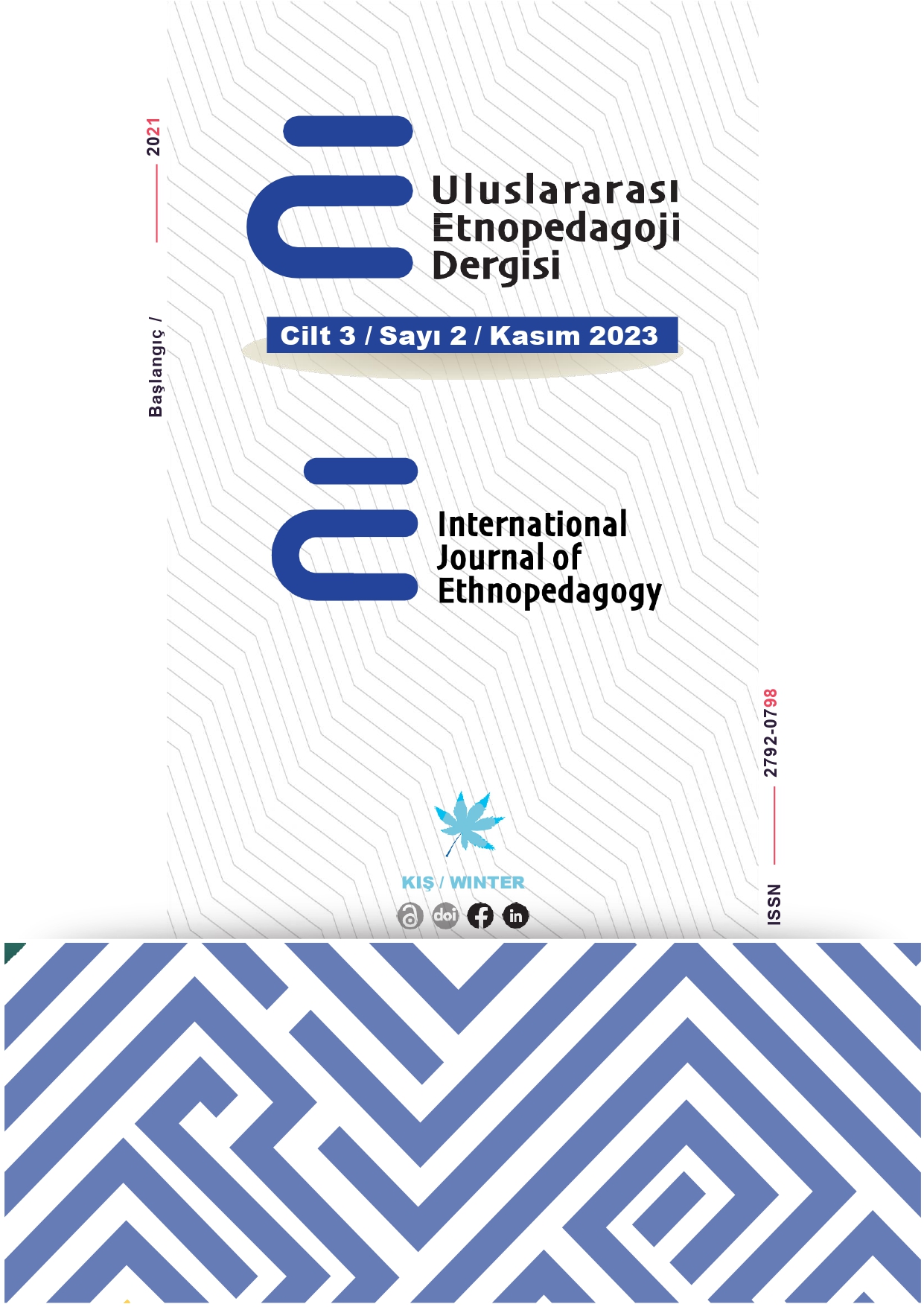Formation and Development of Education of Armenians in Taurian Province
DOI:
https://doi.org/10.5281/zenodo.10350117Keywords:
Education, Education Of Armenians, Taurida Province, Armenian-Gregorian Church, G. Aivazovsky, Armenian National Culture, Polyethnic RegionAbstract
Introduction: The article aims to analyze the historical aspects of the foundation of confessional (Armenian) educational establishments in Taurida province in the 19th- early 20th century in order to use their experience in reforming the modern educational system. Materials and Methods: The research methodology is based on the general scientific principles of historicism, systematic, and scientific objectivism as means of studying the educational systems foundation and development; ideas of the modern philosophy of education. The authors guided by the basic ideas of the anthropological, humanistic, multicultural, cultural, and regional approach to social, pedagogical factors, its phenomena and processes. Discussion: The results of the research demonstrate that the development of educating the Armenians on the territory of Taurida province within the researched period was rather ambiguous. On the one hand, national schools were opened, magazines were published, and books were printed. On the other hand, the government attempted to put an end to the independence of the Armenian church parish schools, to close them, but the schools continued to exist until 1917. Results: The foundation and development of the education of Armenians in Taurida province are considered to be a certain historical, socio-pedagogical phenomenon, a system of values and knowledge that contributed to the preservation of the Armenian ethnos and the national education system as its structural elements. Conclusions: Despite the difficult stages in the development of the education of Armenians in Taurida province while the researched period, they were able to preserve their culture, language, education and educational traditions.
References
Arutyunova-Fidanyan V. A. (1998). Ethno-confessional ideas of the Armenian-Byzantine nobility in the 11th-12th centuries. Elite and ethnos, 178–188.
Arutyunova-Fidanyan V. А. (2000). Byzantine ideologems in the Armenian historiography of the X-XI century. Comparative research of civilizations of the world (interdisciplinary approach), 217–230.
Atabekova A., Rimma G., Shoustikova T. (2016). University Academic Excellence and Language Policy: a Case of Russia. The International Journal of Environmental and Science Education, October 23: 9390–9397.
Berson A.B. (2011). European metropolis and multiculturalism: Degree of compatibility. Contemporary Europe 1: 57–70.
Birdsall S. (2013). Reconstructing the relationship between science and education for sustainability: A proposed framework of learning. The International Journal of Environmental and Science Education, July 10: 451–478.
Chuvarayan L. (2015). Origins. Crimea is a sea in Armenia. Resettlement of Armenians from Crimea to the Don. Scientific community of students of the XXI century. Social Sciences: Sat. Art. By mat. XXXIV Intern. Scientific-practical. Conf, 7(33): 19– 24.
Cumming J. (2013). Two issues in educational research: A response to «Reviewing education concerns». Journal of Hospitality, Leisure, Sport & Tourism Education, 13: 1–4.
Dolzhikova A., Moseikina M., Vladimirsky I. (2016). The Educational Policy Strategy on Foreign Citizens Coming to the Russian Federation, as a Factor of Their Socio-Cultural Adaptation and İntegration. The International Journal of Environmental and Science Education, 11: 2619–2634.
Fisk M. (2005). Multiculturalism and Neoliberalism. Praxis Filosofica, 21:21–28.
Fokin, V., Baryshnikov, V., Bogoliubova, N., Nikolaeva, J., Ivannikov, I., Portnyagina, M., Ryazantseva, N., Eltc, E., Chernov, I. (2016). Multiculturalism in the Modern World. The International Journal of Environmental and Science Education. November 11, 10777–10787
Gankevich V. YU. (2001). The structure of national and confessional education of ethnic groups of the Taurida Province (the borderline of the XIX-XX centuries). Scientific notes of the Taurida National University named after. VI Vernadsky. Series X: History, 14 (53): 3–8.
Huntington S. (1993). The clash of civilizations? Foreign Affairs, 72(3): 22–49.
Ivanovaa A, Filippovaa N., Vinokourovа E. (2016). Formation of Intercultural Identity in Children of Nothern People in a Multilingual Context. The International Journal of Environmental and Science Education, 11: 9999–10009.
Kanarsh G. (2011). Multiculturalism: social concept and social practices. Knowledge, understanding and skill, 1: 87–94.
Khuziakhmetov, A.N., Shafikova, G. R., Kapranova, V. A. (2015). Conditions of Educational Environment for the Development of Teenagers’ Moral Relations. The International Journal of Environmental and Science Education, July 07, 515-521.
Maximovaa O., Belyaeva V., Laukart-Gorbachevaa O., Nagmatullinaa L., Hamzinaa G. (2016). Russian Education in the Context of the Third Generation Universities` Discourse: Employers’ Evaluation. The International Journal of Environmental and Science Education, 11: 9101-9112
Mendivil, (2002). The new providers of higher education. Higher Education Policy, 15: 353 – 364.
Mokeyeva, E. V., Andreeva, I. N. (2016). Civic and Patriotic Education of Pre-School Children. The International Journal of Environmental and Science Education, 2223–2236.
Potekhin V.Ye., Potekhin D.V. (2001). Multinational Crimea. The Armenians. Together, 1: 9–11.
Shibankova L., Dolganovskaya N., Ishmuradova A., Matveeva E., Vlasova T. (2016). Pedagogical Conditions of Interethnic Relations Correction in Educational Environment. The International Journal of Environmental and Science Education, 11: 10401–10412.
Shushara, T.V. (2015). Status of Women's Education in Taurian province in XIX - early XX century. Pedagogika, 105: 124–133.
Sinyagina, N. Y., Rayfschnayder, T. Y. (2016). The policy of multicultural education in Russia: focus on personal priorities. The International Journal of Environmental and Science Education. December 19, 12613-12628.
Slavin R. (1999). Educational research in the 21st century: Lessons from the 20th. Issues in education, 5, Is. 22: 261–266.
Stenseth T., Bråten I., Helge I. (2016). Investigating interest and knowledge as predictors of students' attitudes towards socio-scientific issues. Learning and Individual Differences, 47: 274–280.
Zorina, A. V., Vygodchikova, N. N., Gatin, R. G., Nazmutdinova, M. A., Gerasimova, O. Y. (2016). Multicultural Education of Multi-Ethnic Students at the Foreign Language Class. The International Journal of Environmental and Science Education. Number 11, 10817–10827.
Zorkin, V. (2011). Modern state in the age of ethno-social diversity. Speech of the President of the Constitutional Court of the Russian Federation. Russian newspaper site, September 7. Direct access: https://rg.ru/2011/09/07/zorkinsite.html
Downloads
Published
How to Cite
Issue
Section
License
Copyright (c) 2023 Uluslararası Etnopedagoji Dergisi

This work is licensed under a Creative Commons Attribution 4.0 International License.



